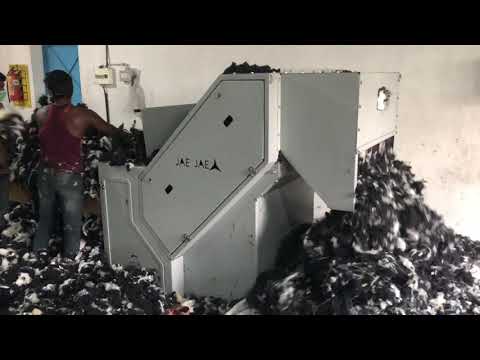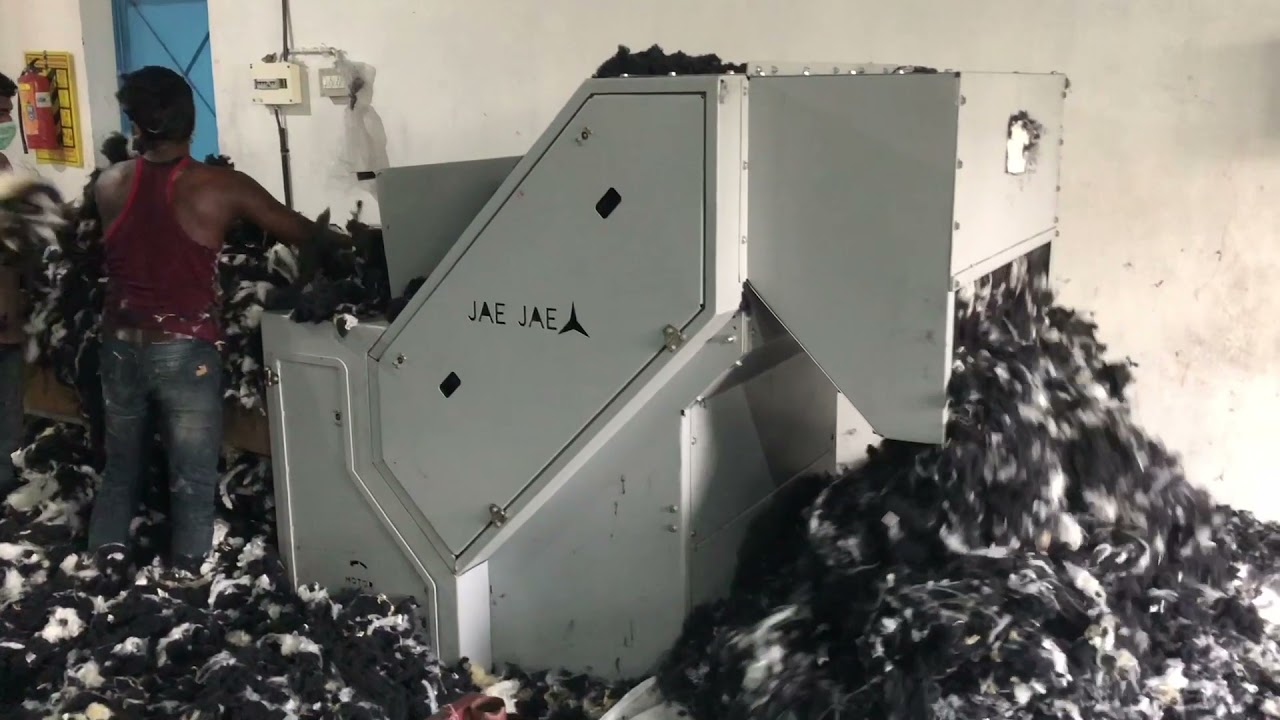Recycled cotton fabric is a revolutionary textile that not only offers impeccable quality but also contributes to a sustainable future. Made from discarded cotton garments, this fabric undergoes a meticulous process that transforms waste into a valuable resource. By diverting cotton waste from landfills and reducing the need for new cotton production, recycled cotton fabric actively supports environmental conservation. Its production requires significantly less water, energy, and chemicals compared to conventional cotton, making it an eco-conscious choice. But it's not just about sustainability – this fabric is incredibly versatile and stylish too! It retains the same softness, durability, and breathability as conventional cotton, guaranteeing utmost comfort. Whether you're looking for cozy loungewear, trendy apparel, or even home textiles, recycled cotton fabric has got you covered. Its unique texture and beautiful colors make it a favorite among designers and fashion-forward individuals. Embrace the future of fashion and join the movement towards a greener planet with recycled cotton fabric – a choice that allows you to look good, feel good, and make a positive impact on the world.

Recycled Cotton Fabric: A Sustainable Solution for a Greener Future
Recycled cotton fabric is a revolutionary eco-friendly textile that is gaining popularity due to its numerous environmental benefits. As the fashion industry continues to grapple with sustainability challenges, recycled cotton fabric offers a viable solution to reduce waste and minimize the industry's carbon footprint. In this article, we will explore what recycled cotton fabric is, its manufacturing process, its advantages, its applications, and its impact on the environment.
What is Recycled Cotton Fabric?
Recycled cotton fabric is made from post-consumer or pre-consumer cotton waste, such as discarded clothing, textile scraps, or industrial waste. Instead of ending up in landfills, these cotton materials are collected, sorted, and processed to create new yarns, which are then woven into fabric. This process significantly reduces the need for virgin cotton, conserves resources, and minimizes the environmental impact associated with traditional cotton production.
The Manufacturing Process of Recycled Cotton Fabric
The production of recycled cotton fabric involves several key steps. First, cotton waste is gathered from various sources, including textile manufacturers, clothing brands, and recycling centers. The collected waste is then sorted based on color, fiber length, and other specifications to ensure consistent quality in the final fabric.
Next, the sorted cotton waste undergoes a mechanical or chemical process to break it down into fibers. Mechanical recycling involves shredding the waste into small pieces, while chemical recycling uses solvents to dissolve the waste and extract the fibers. Both methods have their advantages and are chosen based on the desired outcome and the type of waste being recycled.
Once the cotton fibers are obtained, they are spun into yarns using spinning machines. These yarns are then woven or knitted into fabric, which can be used for various applications in the textile industry. The final recycled cotton fabric may possess similar qualities to conventional cotton fabric, such as softness, breathability, and durability, making it suitable for a wide range of products.
The Advantages of Recycled Cotton Fabric
Recycled cotton fabric offers several advantages over traditional cotton fabric, making it an attractive choice for environmentally conscious consumers and businesses:
1. Waste Reduction: By utilizing cotton waste that would otherwise end up in landfills, recycled cotton fabric helps to reduce textile waste and promote a circular economy.
2. Energy Conservation: The production of recycled cotton fabric requires significantly less energy compared to virgin cotton production. This reduction in energy consumption helps to lower greenhouse gas emissions and mitigate climate change.
3. Water Conservation: Conventional cotton production is notorious for its high water consumption. Recycled cotton fabric, on the other hand, requires less water during the manufacturing process, contributing to water conservation efforts.
4. Chemical Reduction: The manufacturing of recycled cotton fabric involves fewer chemicals compared to traditional cotton production, reducing the release of harmful substances into the environment and minimizing the impact on ecosystems.
5. Versatility: Recycled cotton fabric can be used in a wide range of textile applications, including clothing, home textiles, accessories, and even industrial products. Its versatility makes it a compelling choice for designers and manufacturers seeking sustainable alternatives.
Applications and Impact on the Environment
The use of recycled cotton fabric has a positive impact on both the environment and the fashion industry. By incorporating recycled cotton fabric into their products, brands and designers can showcase their commitment to sustainability and meet the growing demand for eco-friendly options.
Recycled cotton fabric can be used to create various clothing items, such as t-shirts, jeans, sweaters, and more. It can also be utilized in home textiles like bed sheets, towels, and curtains. Additionally, the industrial sector can benefit from recycled cotton fabric in the production of insulation materials, cleaning cloths, and packaging materials.
Overall, the use of recycled cotton fabric helps to reduce the demand for virgin cotton, which requires extensive land usage, water, and pesticides. It also diverts textile waste from landfills, reducing the environmental impact associated with textile disposal. By choosing recycled cotton fabric, consumers and businesses can contribute to a greener future and support a more sustainable fashion industry.
In conclusion, recycled cotton fabric is a sustainable and eco-friendly alternative to conventional cotton fabric. Its production process reduces waste, conserves energy and water, and minimizes the use of chemicals. With its versatility and positive impact on the environment, recycled cotton fabric is paving the way for a greener future in the textile industry.
Title: “Reviving Fashion: Unveiling the Thriving Journey of Recycled Cotton”
The Recycled Cotton Process:
Recycled cotton, an eco-friendly alternative in the fashion industry, undergoes a fascinating transformation. Initially, discarded cotton textiles are collected from various sources, such as post-consumer garments or pre-consumer waste from textile factories. These materials are meticulously sorted based on color, texture, and quality to ensure optimal results.Next, the sorted cotton undergoes a thorough cleaning process to remove impurities, such as dirt, dyes, and buttons. The cleaned cotton is then broken down into individual fibers through mechanical or chemical means, depending on the desired outcome. This step is crucial in restoring the cotton's natural form and texture.
Once the fibers are separated, they are spun into yarns, much like traditional cotton production. These recycled yarns can be blended with other sustainable fibers like hemp or organic cotton to enhance their durability and versatility. The resulting yarns are meticulously dyed using eco-friendly pigments or left undyed, preserving the natural colors of the recycled cotton.
Finally, these recycled cotton yarns are ready for the skilled hands of designers and manufacturers, who transform them into a wide range of fashion products. From trendy clothing items to stylish accessories, the possibilities are endless.
The recycled cotton process breathes new life into discarded textiles, reducing waste and minimizing the industry's environmental footprint. By embracing this innovative approach, the fashion world takes a significant step towards a more sustainable and ethical future.
Video Source : Textile Pioneers
Recycled Cotton Fabric
Recycled Cotton Fabric
| Property | Description |
|---|---|
| Composition | Recycled cotton fabric is typically made from post-industrial and post-consumer cotton waste. It consists of fibers that are regenerated from discarded clothing, textile scraps, or manufacturing byproducts. |
| Sustainability | Recycling cotton reduces the need for virgin cotton production, which significantly saves water, energy, and reduces greenhouse gas emissions. By utilizing textile waste, this fabric supports a circular economy and helps mitigate the environmental impact of the fashion industry. |
| Softness | Despite being recycled, cotton fabric retains its inherent softness, ensuring comfortable wear for various applications. It undergoes a meticulous recycling process that maintains the quality of the fibers, resulting in a fabric that is gentle on the skin. |
| Strength | Recycled cotton fabric possesses excellent strength properties, allowing it to withstand regular use and frequent washing. The recycling process ensures that the fibers maintain their integrity, providing durability comparable to conventional cotton fabric. |
| Versatility | Recycled cotton fabric is highly versatile and can be used in a wide range of applications, including clothing, home textiles, upholstery, and accessories. Its adaptability makes it a valuable resource for sustainable fashion and interior design industries. |
| Color and Design | Recycled cotton fabric can be dyed and printed in various colors and patterns. It offers endless possibilities for creativity, enabling designers to create unique and aesthetically appealing products while contributing to a more sustainable future. |
Note: The information provided above is based on industry expertise and research in the field of recycled cotton fabric.

